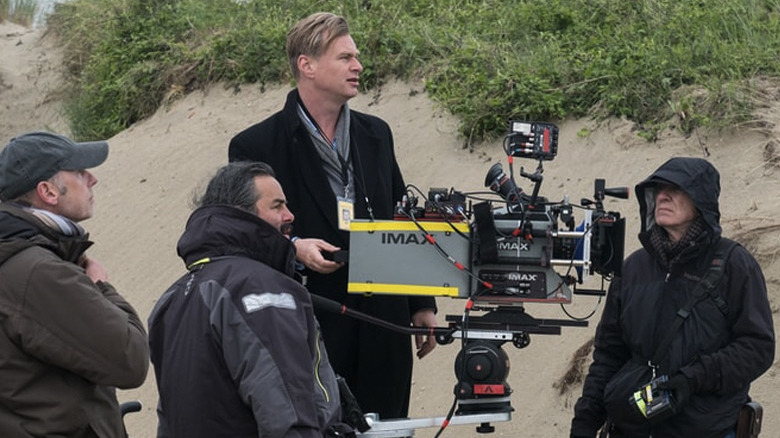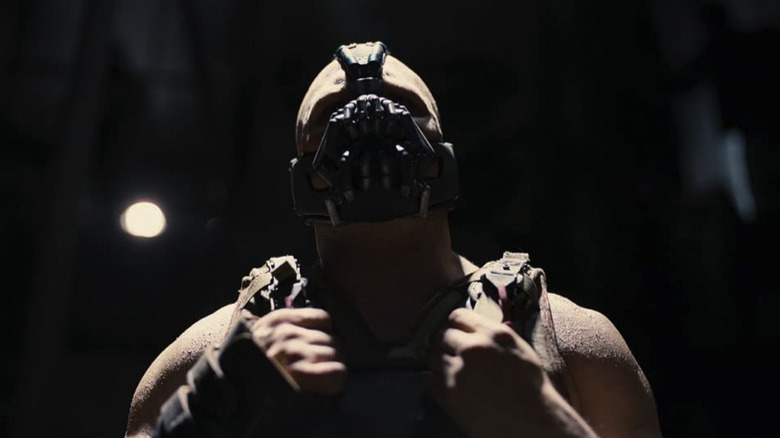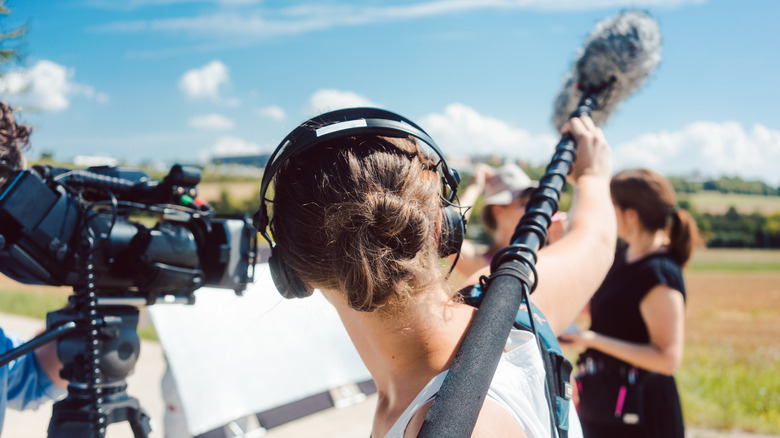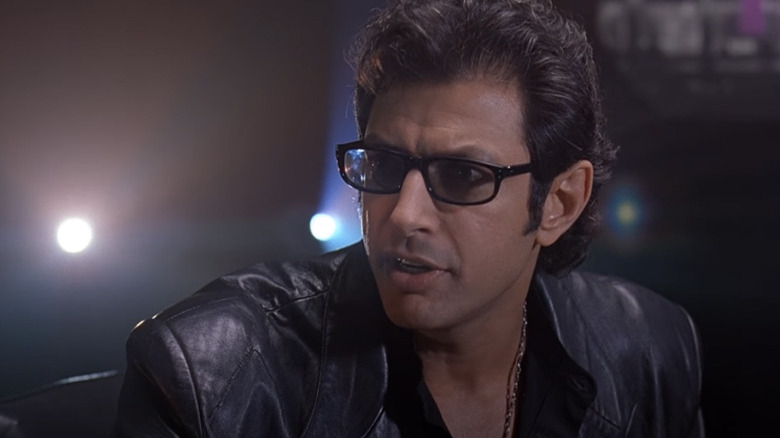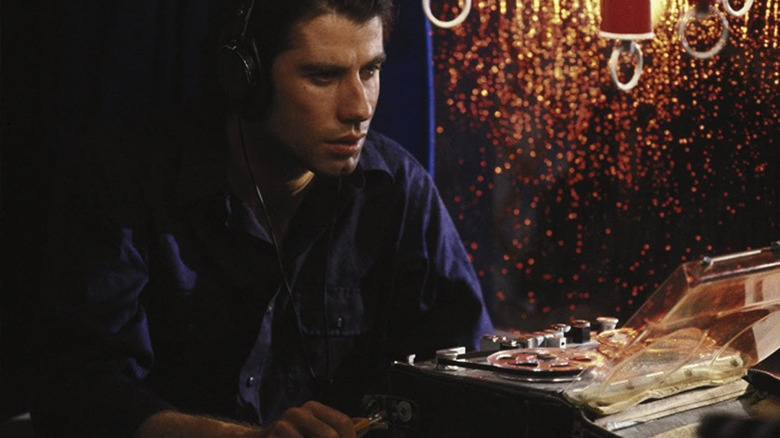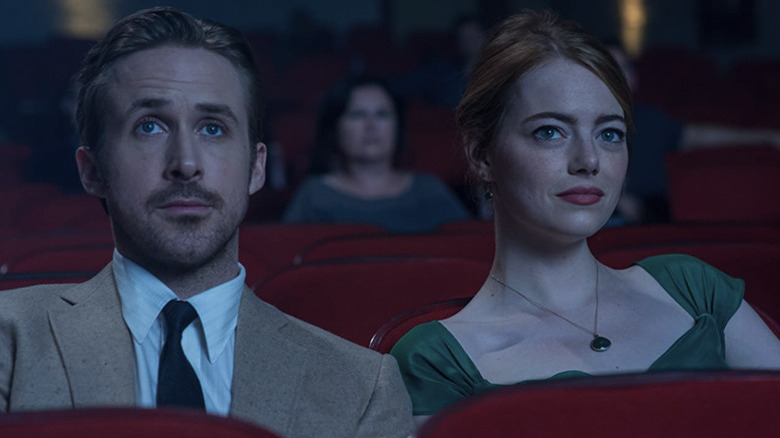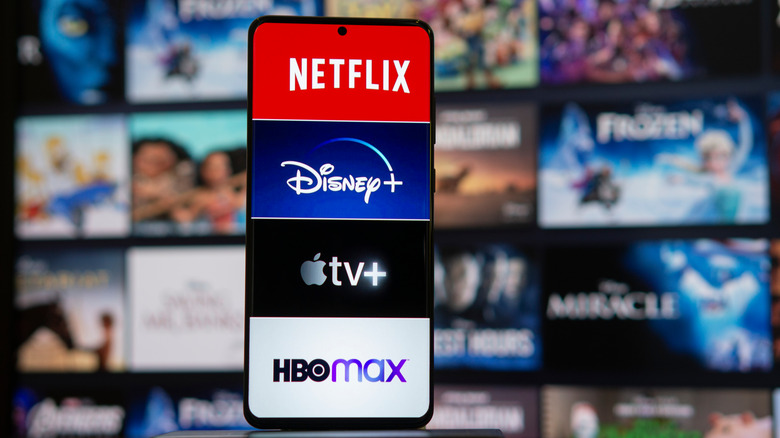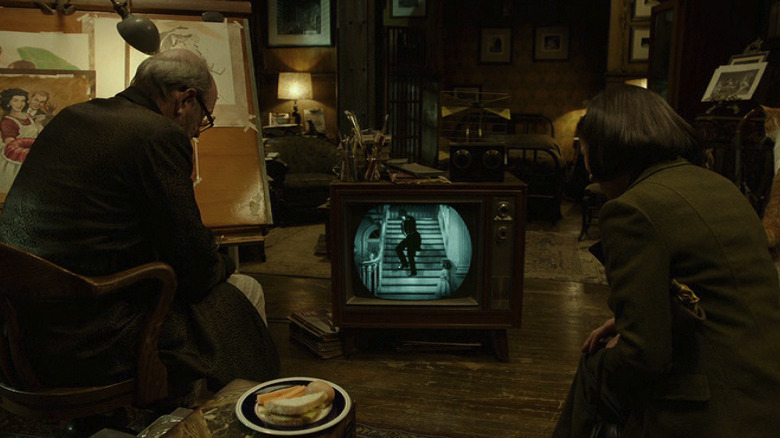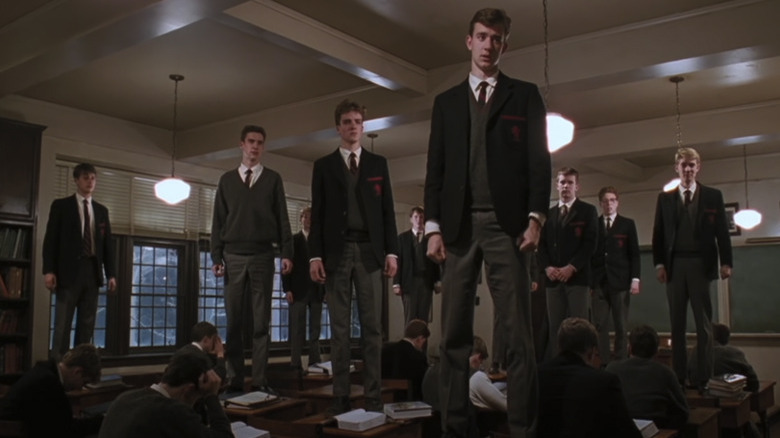Here's Why Movie Dialogue Has Gotten More Difficult To Understand (And Three Ways To Fix It)
I used to be able to understand 99% of the dialogue in Hollywood films. But over the past 10 years or so, I've noticed that percentage has dropped significantly — and it's not due to hearing loss on my end. It's gotten to the point where I find myself occasionally not being able to parse entire lines of dialogue when I see a movie in a theater, and when I watch things at home, I've defaulted to turning the subtitles on to make sure I don't miss anything crucial to the plot.
Knowing I'm not alone in having these experiences, I reached out to several professional sound editors, designers, and mixers, many of whom have won Oscars for their work on some of Hollywood's biggest films, to get to the bottom of what's going on. One person refused to talk to me, saying it would be "professional suicide" to address this topic on the record. Another agreed to talk, but only under the condition that they remain anonymous. But several others spoke openly about the topic, and it quickly became apparent that this is a familiar subject among the folks in the sound community, since they're the ones who often bear the brunt of complaints about dialogue intelligibility.
"It's not easy to mix a movie," says Jaime Baksht, who took home an Oscar for his work on last year's excellent "Sound of Metal" and previously worked on Alfonso Cuarón's "Roma." "Everybody thinks you're just moving levers, but it's not like that."
This problem indeed goes far beyond simply flipping a switch or two on a mixing board. It's much more complex than I anticipated, and it turns out there isn't one simple element that can be singled out and blamed as the primary culprit.
"There are a number of root causes," says Mark Mangini, the Academy Award-winning sound designer behind films like "Mad Max: Fury Road" and "Blade Runner 2049." "It's really a gumbo, an accumulation of problems that have been exacerbated over the last 10 years ... that's kind of this time span where all of us in the filmmaking community are noticing that dialogue is harder and harder to understand."
Join me and these industry experts as we sort through that "gumbo" and identify some of the most prominent reasons it has become more difficult to, in the paraphrased words of Chris Tucker's Detective Carter in "Rush Hour," understand the words that are coming out of characters' mouths.
It's A Purposeful Choice
When it comes to dialogue unintelligibility, one name looms above all others: Christopher Nolan. The director of "Tenet," "Interstellar," and "The Dark Knight Rises" is one of the most successful filmmakers of his generation, and he uses his power to make sure his films push the boundaries of sound design, often resulting in scenes in which audiences literally cannot understand what his characters say. And it's not just audiences who have trouble with some Nolan films: the director has even revealed that other filmmakers have reached out to him to complain about this issue in his movies.
Donald Sylvester, who took home an Oscar for his work on "Ford v Ferrari" and is currently serving as the supervising sound editor of "Indiana Jones 5," says Nolan is a singular figure in this regard. "I think Christopher Nolan wears it as a badge of honor," Sylvester declares. "I don't think he cares. I think he wants people to give him bad publicity because then he can explain his methods to everybody and we can all learn. But I don't think other people actually understand it."
Baksht thinks the complaints about Nolan's work, specifically the hubbub about unintelligibility surrounding last year's twisty action thriller "Tenet," are overblown. "I think in the case of Mr. Nolan, with ["Tenet"], the characters have a mask, and he wants to keep the original sound because I think for him it's more real," he says. Presumably, that mentality also extends to "The Dark Knight Rises," in which Bane's mask muffled a significant percentage of that character's lines.
Thomas Curley, who won an Oscar as a production sound mixer on "Whiplash" and previously worked on "The Spectacular Now," has also seen this type of mentality at work. "Not everything really has a very crisp, cinematic sound to it in real life, and I think some of these people are trying to replicate that," he tells me.
Baksht says that type of creative aesthetic does not need to permeate an entire movie — it can sometimes change from scene to scene depending on the director's goals in telling the story. Although, as this anecdote illustrates, its effectiveness remains debatable:
"In the case of Alejandro González Iñárritu, he did a movie ['Biutiful'] where all the dialogue was really dirty. They were in Spanish, but you weren't able to understand much. When I asked his sound designer about this issue, he told me the reason they wanted to keep the dirty dialogue was because the situation was so awful in the life of the character that it helped the feeling of depression. I told him, 'Yes, I think the audience got depressed because they couldn't understand anything!' But when [Iñárritu] did 'The Revenant,' the dialogue was pristine and perfect."
I understand his point, although I take issue with using "The Revenant" as an example of pristine dialogue because that film features Tom Hardy in a supporting role, and Hardy is one of the most notoriously difficult-to-understand actors working today.
It's in the Acting
Hardy occupies a unique position in film acting these days, having developed a delivery style that's frequently so indecipherable it's as if he's purposefully challenging audiences to lean in and understand what he's saying. But what about actors who aren't quite on that level of unintelligibility?
"It seems to be a little bit of a fad with some actors to do the sort of soft delivery or under your breath delivery of some lines," Curley says. "That's a personal choice for them. Our job is to record it as well as we can regardless."
Mangini says that in the old days, "you could count on an actor's theatricality to deliver a line to the back seats." But acting styles have changed so dramatically over the years that it has become much more difficult to capture great sound on the set. When actors adopt that more naturalistic style, "it's even harder for the production sound mixer to capture really quality sound. Now we get those compromised microphone positions here in post-production, reaching for a dialogue line that is barely intelligible or maybe even mumbled because it's an acting style, and already, we're behind the 8-ball in trying to figure out a way to make all of those words intelligible."
Karen Baker Landers, whose credits include "Gladiator," "Skyfall," and "Heat," among many others, has her own term for it. "Mumbling, breathy, I call it self-conscious type of acting, is so frustrating," she says. "I would say a lot of the younger actors have adopted that style. I think the onus also falls on the directors to say, 'I can't understand a word you're saying. I'm listening to dailies, and I can't understand.' No amount of volume is going to fix that."
That naturalistic performance style might feel right for actors in the moment on set, but it can be hell for the sound professionals who have to clean it up afterward. "We're very careful to make sure there's clarity," Baker Landers says. "You go in and you volume-graph up a vowel, or one letter. You go in and you surgically – maybe if it's not right on camera, you slow it down. There's all kinds of things we spend hours trying to do that may help a performance. We really strive for that."
But they can only do so much.
Sound Isn't Respected Enough On Sets
Another ingredient in this complicated gumbo is how the sound team is treated during the process of filming.
"What we see from our brothers and sisters in production is a never-ending [complaint] that they don't get the respect they need to get the microphone where it needs to be to capture the sound clearly," Mangini says. "That's because as movies have matured in the last 15 years, movies have become more visually exciting. And because of that, it is less likely that you're going to be allowed to put that boom mic right where the actor is, because it's probably going to drop a shadow because it's in front of a light that the camera team insists has to exist to get the perfect look of the shot. So [the visuals have] taken precedence over what we hear."
Sylvester agrees with that sentiment. "If the sound guy goes, 'Can you get one more take for me?' they go, 'Nope, we're wrapping. We've gotta move on to another setup.' It's because pictures are the most important thing, and we do a good job fixing sound at the end of the day. So they go, 'We'll fix it in post.' That's literally their go-to answer. 'I just need to get this.' 'Yeah, we'll fix it later.' And we do, unfortunately. But it's not because we want to. It's because we have to."
Another "Whiplash" Oscar winner, Craig Mann, acknowledges that less time on set can have a negative effect on the sound crews. "There's more demand on crews to do many setups a day, and that could be a contributing factor," he says. "The production sound guy is the tip of the spear in terms of our first line of defense, and oftentimes if there are problems, the good ones will approach the director or the AD or the DP and say, 'Hey, this isn't working, you're going to miss this.' Oftentimes it gets handled. But on the other side, sometimes there are a lot of production sound guys that do not feel empowered or have had a bad experience about speaking up in the past, or whatever the reason is, and the material gets back to the cutting room and it's a mess, and [they say], 'Well, we thought everything was fine!'"
"I would blame it more on schedule and budget and maybe trying to rush," Baker Landers says when this topic arises. "It's an art form to be a dialogue editor. It's an art form to be a great production recordist. Then to be able to get the clarity of dialogue in a mix with everything else going on and have the dialogue feel natural and not forced is another art form, all of which take time. Budgets and schedules are crunched on a lot of projects, and some of these are amazing films."
Technology (AKA The Jurassic Park Problem)
One high-profile Hollywood sound professional who wishes to remain anonymous points to the evolution of technology as an ingredient. "The reason people don't remember having these same audio issues with older films is that [now] we have more: more tracks to play with, more options, therefore more expected and asked for from the sound editors," they say. "If you listen to, say, 'Four Weddings and a Funeral,' you'll hear every word ... the sound was cut on film back then, and with limited time, track count, and budget, these are the results you got."
Thomas Curley concurs with that assessment:
"A lot of it has probably happened more recently because of the almost ubiquitous use of digital audio and digital cinema now. Part of the reason with that is because when everything was shot on film and edited with tape, it was a much more laborious process and it was much more technically challenging to do a whole lot with sound design. Everything had to be a very conscious choice and a very intentional soundscape that they create. Since it was so cost-intensive and labor-intensive, they wanted to make sure that the story got across first and emotion gets sort of directed with music, and that's about it. And every pass that you do with an analogue system depletes the quality as well: it's like making a photocopy of a photocopy. But now, they have much faster turnarounds and much more capabilities as far as what they can do with the sound design, including playing around with ambience and sound effects. To put a concrete reason on it is hard, but a lot of it comes down to 'I have this toy, so I'm going to play with it.'"
The anonymous sound pro also pointed to what they view as an increase in the amount of music in modern movies compared to older films, bemoaning directors' over-reliance on music as "pushing emotion" on audiences and the way music and dialogue are forced to jostle for prominence in the mix. "The technology we have today is so vastly improved that there is no limit to what can be added: whatever the director wants, for months on end. We literally have hundreds of tracks at our disposal ... in a final mix, we therefore have a lot to deal with. Unending score smashed up against hundreds of tracks, with the client asking to hear every nuance above every other nuance."
Curley sums it up beautifully. "It might fall into the realm of the 'Jurassic Park' thing: they spend so much time realizing that they can do all these things, but not thinking about if they should do all these things."
Familiarity/Passive Listening
All four of those contributing factors to dialogue unintelligibility are the result of decisions made on sets. But by the time a film makes it to post-production, editors can be afflicted by something Karen Baker Landers calls "passive listening." Donald Sylvester has another name for it – "familiarity" — and it's exactly what you think it is.
"What I mean by familiarity is, when we're making a movie, it takes a long time," says Sylvester. "It takes weeks and months. If there's something that's unclear at first and you turn to the guy next to you and go, 'What did he say?' and he's like, 'Bring the car around the garage.' The next time you hear it, you go, 'Oh, OK, got it. Bring the car around the garage.' But they get familiar with the bad sound to the point where they no longer find it to be a problem."
Mark Mangini puts it like this:
"The director is sick of talking to the writer and giving them rewrites, sick of talking to the actors and giving them line reads, and by the time you get to post, every single syllable is known by heart. So imagine what that creates in a sound mix where we're supposed to correct the dialogue. We're no longer critically listening like we should be. Because we're in fact zoning out on whether or not the audience is actually getting the critical information they need. We know what the critical information is: we've been dealing with it for months. So in a sense, we have to challenge ourselves daily – and we certainly do this in sound – to try to remove ourselves from that equation and re-inject ourselves with a fresh perspective to see if we're actually making clear dialogue such that the audience understands it."
In Craig Mann's experience, though, the idea of familiarity is not a widespread issue. "As someone that does this on a daily basis, I think dialogue clarity is the number one priority on the mixing stage," he tells me. "Dialogue, music, and effects, in that order, is usually the chain of priority. If you can't hear the dialogue, we're going to find a way to hear it. Just speaking of the couple things that we've done even this past year, I can say Joe Carnahan, writer/director, wants to hear every word. Tyler Perry, we just did something with him, wants to hear every word. Sean Penn wants to hear every word. So I don't necessarily agree with getting numb to it. I think it's incumbent upon us to have that fresh ear every time we show up."
Sylvester also points out that unfamiliarity may be an issue in some instances. "What I'm wondering is if, sometimes, some of these films that we see, people are saying words that we don't know what they mean, such as 'Dune,' where they start talking about characters and places that sound unfamiliar. They do it in such a way, offhandedly, where it's like, 'What did he say?' Some of it is the content."
Mixing For Cinemas
One of the most fascinating things I learned when speaking with these folks is the gulf in quality that can sometimes occur between what a film sounds like in the mixing stages and what it can sound like when it plays in a multiplex. Mann says this isn't a new problem — it's actually been happening for decades:
"You mix it at your level in the mixing room, and theoretically, that is supposed to be the same level that is represented in the movie theaters on the Dolby Cinema processors, therefore giving you an exact translation, more or less, of what you've done on the mixing stage. But what's happened is, particularly in the '90s, because that felt like the time when they were doing the loudest mixes – I didn't mix in those times, but the stories were that mixers and maybe directors would want stuff mixed at a level that was just ear-bleeding. And what would happen is, that would get to the theater, there would be complaints from the patrons, and the theater would be compelled to turn down the mix. And when the next feature came in the next week, the level was never reset, and now that level is playing way low for the regularly mixed movie. That's a problem that vendors have been dealing with for many years. I know [it's still happening]. For example, the Landmark Theater chain does not play their theaters above 5.5 on the cinema processor, where the set standard is supposed to be 7 on that processor."
The idea that a significant theater chain would purposefully ignore industry standards for something as crucial as sound is genuinely shocking. I reached out to Landmark's customer service and asked them directly about this issue, but they did not respond in time for publication.
Thankfully, I have not heard any similar stories about AMC Theaters, the largest theater chain in the United States. However, I was curious about the configurations that occur when a new sound system is installed in an AMC cinema, how frequently their systems are upgraded or replaced, and how the company maintains quality sound conditions across its vast empire of theaters. I reached out to AMC, and they responded with this statement:
In general, our guest feedback, both recently and stretching back the last several years, does not match your assessment about dialogue becoming more difficult to understand. Among guest feedback, which is tracked through survey results and through incoming contacts from guests, there has not been an increase in complaints as a result of the audio, regardless of the type of movie. Regarding your questions about our sound equipment, our speakers and sound systems are calibrated upon installation. They are routinely checked, and recalibrated whenever necessary to ensure the best possible sound quality.
Additionally, for guests who would like to follow the dialogue on screen, AMC now offers Open Caption showtimes at 240 of our locations, and in every major market in the United States with at least two AMC theatres.
Meanwhile, Baker Landers thinks part of the trouble may have begun when theaters shifted away from projecting movies on film. In that transition, union projectionists — the people who knew the ins and outs of how to properly present a movie with care — were largely kicked to the curb in favor of inexperienced employees who essentially pressed play on a digital system and could then busy themselves doing other tasks. She tells me a story about how she went to see one of her own movies at a big multiplex and the auditory experience was so bad, she was compelled to point it out to the manager.
"I did a film that was [played] at a 4 [out of 7 on the processor scale]," she says, still appalled by the memory. "I was at a matinee with a lot of elderly people because I took my mom, and I'm like, 'None of these people can hear what's happening.' The manager, who was probably all of 22 years old, said, 'Well, that's how the film was done.' And I said, 'No, I did the sound on the film. That's not how it was done.'"
When sound pros encounter those dumbfounding levels of separation between the mixing stages and theaters, Mann says there can be a schism about the best way to move forward:
"You're going to have some people on the mixing stage who want to turn [up that volume higher than the standard of 7] to compensate for the fact that theaters are playing it low. But [if you do that,] when you go to those theaters that are calibrated correctly, you're going to blow the doors off that theater because it's going to be ripping loud. So one thing we always try to tell our people is that you have to be happy with the mix in the properly calibrated environment, and when you go down to your local movieplex, the speaker could be blown, the level could be low, God knows what's going to happen when you're out in the wild, and we can't control all of that."
Baker Landers knows on which side of that divide she falls. "We mix and release the film for the best case scenario, saying, 'This is how it should be.' A lot of times, we'll hear people say, 'They're not going to be able to hear this in certain theaters in the Midwest, so should we do this louder?' But then you don't have a standard any longer. You have to say, 'This is the standard. We're doing it for the optimum viewing experience.' And hopefully theaters and everyone else rise to that."
Mixing For Streaming
Mixing sound for theaters can be tough, but mixing sound specifically for streaming has its own set of challenges. "We, in fact, do a separate mix for streaming," Mangini says (although I later learned this isn't true for every single movie across the board). But since nothing is ever easy, another problem arises when streaming enters the picture: compression. In layman's terms, think of compression as audio files basically being shrunk down in order to be efficiently transported across the Internet to your viewing device. That process sounds almost magical, doesn't it? It is — until you realize that those shrunken files are of significantly lower quality than what you'd get if you watched that same movie on a Blu-ray. (If you're keeping score at home, this is yet another point in favor of preserving physical media at all costs.)
"Very often, the streamed audio is a compressed version that you wouldn't get on a Blu-ray," Mangini explains:
"On Blu-ray, if you select 7.1, that is our full fidelity, 48 kilohertz, 24-bit master audio, just as it came from the mixing studio. You can get that on a Blu-ray, and you can get that on certain premium platforms. I think you have to pay extra money for that. But otherwise, it's most common that when you stream, you get a degraded version of what you mix that even we didn't approve. It's done after the fact, after we ship the masters. The only way [streamers] can get the bandwidth they need for you to see image and sound in sync is to compress everything."
Compression is inescapable when streaming is involved, but it turns out not all streaming platforms are created equal. Craig Mann tells me something he says "is not well-known" outside the sound community: different streamers have different specifications when it comes to their audio mixes. "Netflix has excellent specs in terms of dialogue norm and overall levels," he reveals. "They need a particular level in order to pass quality control, and the level is essentially based on the dialogue level throughout the length of the program."
But since there's no industry standard in how to measure audio for streaming, other platforms base their levels on other parts of the sound mix. Case in point: Mann recently worked on Joe Carnahan's "Boss Level," which was originally meant to be a theatrical release. "For a variety of reasons, it ended up at Hulu, and when we got a look at that spec, they require it to be based on the overall [volume] of the film, not on the dialogue level of the film. Consequently, that's a big action movie with shooting and cars and big music, and the result of that is that you have a much more squashed up, un-impactful mix ... there are only a couple different ways of measuring these things these days, and I can only imagine that it's somebody just not understanding the reason why it should be this and not that."
Home Theater Woes
There is yet another important variable in this sprawling equation, and it might be the most important one of all: the home theater experience. "Ultimately, the historical record of the film will not be seen in theaters, it will be what you see in your home theater," Karen Baker Landers says. "That's how most people see certain products. So you want it to be great."
For audio mixers, the theatrical mix comes first, followed by a streaming mix. Then, a stereo mix will often be created, funneling the full scope of the sound mix through just two simple speakers in a process Donald Sylvester likens to "taking a beautiful steak and dragging it through the dirt."
"A lot of people watch it on their flatscreen with their sound bar and they think it's going to be an improved sound situation, but it may not translate," says Sylvester:
"Some TVs take the 5.1 [surround sound mix] and they turn it into a stereo. They have algorithms inside the TV. It's not even our mix. We don't even know what it sounds like. I think a lot of tuners do that, if you have a receiver — I know they have algorithms, and they also put coloring on it, like 'cinema approach' that adds reflection and noise and stuff that you don't want in the mix. That's another problem. You don't know how it's being presented in the home."
Complicating matters even further is the unfortunate fact that "not every filmmaker knows that you have to rebalance your film so it plays differently on a home theater," Baker Landers explains. "That's a big problem. Because if you've mixed this for spread in a theater and you just do a simple transfer with some kid at night who doesn't know what they're doing, who didn't [work on] the movie [originally], there's a huge problem with that. I think that problem needs to be addressed. People who aren't in the industry complain to me all the time: 'Why can't I understand the dialogue? Why am I always riding the levels? The music comes in huge.'"
Craig Mann tells me most modern movies are required to create a separate mix for home video, but there is still the occasional film which decides to skip that step in the process. "Those mixes often have less dynamic range than the theater mix," Mann says. "If you're really having to ride the volume around a lot, chances are they didn't have a home theater mix on that."
So, How Do We Fix This?
Now that we know the key issues that are contributing to this lack of intelligibility, what can be done to make things more intelligible? From the sound of it, this problem is going to require a multi-pronged approach.
One prong involves educating people about the importance of sound, from studio execs to the filmmakers themselves. "There's a lot of people who don't prioritize sound," says Thomas Curley. "They know that they need to have it, but they don't necessarily think about it in a very creative way and don't really like to bother with it much."
"Sound is still a mystery to a lot of people," Karen Baker Landers asserts. "It's intangible. With picture, you see it. You understand." Ironically, that lack of understanding of how sound works trickles down to audiences literally not being able to understand what characters are saying on screen. Perhaps if the processes of capturing, creating, and shaping great sound were better understood throughout the industry, substantial steps to improving those processes could be implemented.
Another prong involves sound professionals consistently finding ways to up their game to meet the changing circumstances of the moment. "We can do better in post in terms of how we manage those mixes that are designed specifically for a non-pristine sound environment," Mark Mangini admits. "I would argue that we're probably not doing a good enough job with those mixes, and part of it might be that the individuals who are working in those mixes probably have a really super duper sound system at home and they're not fully aware of how compromised the home environment can be."
That involves thinking outside the box and staying vigilant about the ways the average person is watching a movie. "What can we do technically? I think it's our brain that's the technical solution to this," Donald Sylvester explains. "Because all these gadgets and tools that we use to plug into this are just tools to make the storytelling clearer or better or more exciting. They're just components. At the end of the day, you still have to have a brain telling you what needs to be heard, and when and how ... I think the solution is brain power and being aware of what we're losing in these new presentation environments that people are watching these films in."
The third and final prong involves having tough conversations on the set which establish priorities and make sure everyone is on the same page. Here's a story from Mangini illustrating how having a potentially awkward conversation can result in a change that has a notable improvement on the final product:
"There's a director I've worked with five times, and for four films, we have not had great sound. And this director only makes talky movies. Yet, we still have dialogue intelligibility problems. Mostly because the crew, unbeknownst to him, hasn't respected the sound team on set enough to give them the tools and access they need to get a great recording. It took four films with this director for me to finally get up the gumption to say, 'Dude, you keep telling me dialogue is king in your movies, but you don't put your money where your mouth is. This film, here's what you're going to do: you're going to call a department heads meeting, introduce your sound mixer, and you're going to say, 'See this individual? You have to listen to what he asks you to do, or you're going to answer to me.' And you know what? We got the best track we've ever got. All it took was a little bit of collaboration and communication, and all of a sudden, grip and electric are moving generators a hundred yards away instead of having them right around the corner from the set. It takes an infinitesimal amount of extra effort to get us close to what we need, but it takes somebody with authority to make it happen. Me as the sound designer, I'm not a loud enough voice. But a director is."
Sylvester offers an optimistic closing thought which underlines that point. "There's a lot of people who are moviemakers who aren't technicians, so they don't really understand a lot of this. They just like to make movies. But if we explain to them how we're not getting the message out properly and people aren't getting the message, maybe the artists themselves will take steps to fix it."
